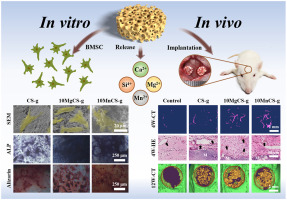Composites Part B: Engineering ( IF 12.7 ) Pub Date : 2020-03-01 , DOI: 10.1016/j.compositesb.2020.107937 Zhiyun Du , Huijie Leng , Liying Guo , Yiqian Huang , Tianyi Zheng , Zhenda Zhao , Xue Liu , Xu Zhang , Qing Cai , Xiaoping Yang

|
Biodegradation and bioinductivity are important factors to decide scaffold efficiency in inducing tissue regeneration. For bone regeneration, calcium silicate (CS) is attractive for its degradation to release Ca2+ and Si4+ ions, which are inductive for osteogenesis and angiogenesis. The doping of Mg2+ or Mn2+ can further strengthen the capacity of CS bioceramic in promoting osteogenesis and angiogenesis. Therefore, CS scaffolds were made by soaking polymeric foam in precursor sol-gels containing different amounts of doping elements and subsequent calcination. Mechanical properties of the scaffolds were improved by gelatin coating. In comparison with the un-doped scaffold, the Mg-doped scaffolds demonstrated lower compression strengths, while the Mn-doped scaffolds displayed higher compression strengths. The ion doping would decrease the degradation and the ion release rates, showing negative dependence on the doping amounts of Mg2+ or Mn2+. The Mg-doped scaffolds promoted the osteogenic and angiogenic differentiation of bone marrow mesenchymal stromal cells (BMSCs) more efficiently than the Mn-doped scaffolds, and both of them had stronger promotion effects on cell activities than the CS scaffold. In vivo evaluations were conducted using the rat calvarial defect model, from which, significant vascularization and new bone formation were identified with the Mg-doped CS scaffolds being implanted for 12 weeks, and the Mn-doped CS scaffolds displayed slightly inferior results. Both the Mg- and Mn-doped CS scaffolds could enhance bone regeneration more efficiently than the CS scaffold. CS scaffolds doped with bioactive elements were deemed as good candidates for bone tissue engineering benefiting from their adjustable biodegradation and bioinductivity.
中文翻译:

硅酸钙支架通过掺杂Mg 2+或Mn 2+离子促进骨骼再生
生物降解和生物诱导性是决定支架诱导组织再生的效率的重要因素。对于骨骼再生,硅酸钙(CS)降解释放Ca 2+和Si 4+离子具有吸引力,而Ca 2+和Si 4+离子可诱导成骨和血管生成。Mg 2+或Mn 2+的掺杂可以进一步增强CS生物陶瓷促进成骨和血管生成的能力。因此,通过将聚合物泡沫浸泡在含有不同量的掺杂元素的前体溶胶凝胶中并随后煅烧来制备CS支架。明胶涂层改善了脚手架的机械性能。与未掺杂的脚手架相比,掺镁的脚手架显示出较低的抗压强度,而掺锰的脚手架显示出较高的抗压强度。离子掺杂会降低降解和离子释放速率,对Mg 2+或Mn 2+的掺杂量显示出负相关性。掺杂Mg的支架比掺杂Mn的支架更有效地促进了骨髓间充质基质细胞(BMSCs)的成骨和血管生成分化,并且与CS支架相比,它们都对细胞活性具有更强的促进作用。体内使用大鼠颅骨缺损模型进行评估,结果表明,植入Mg的CS支架植入12周后,可发现明显的血管形成和新的骨形成,而Mn掺杂的CS支架显示出较差的结果。Mg和Mn掺杂的CS支架都比CS支架更有效地增强骨骼再生。掺杂有生物活性元素的CS支架因其可调节的生物降解能力和生物诱导性而被认为是骨组织工程的良好候选者。











































 京公网安备 11010802027423号
京公网安备 11010802027423号